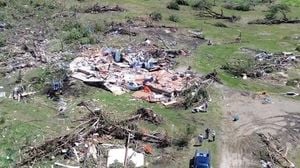Rescue teams in India’s famed Darjeeling region are racing against time after devastating landslides, triggered by relentless heavy rains, killed at least 24 people and left many more missing. The disaster, which struck over the weekend and was still unfolding as of October 6, 2025, has upended daily life in this northeastern tea-growing district and sent shockwaves across South Asia, where extreme weather events are becoming distressingly frequent.
According to the Associated Press, teams of Indian army personnel and members of the National Disaster Response Force have been combing through mounds of debris in search of survivors. Udayan Guha, West Bengal’s state development minister, confirmed that several individuals are feared trapped beneath collapsed homes and infrastructure. The challenging terrain, compounded by ongoing downpours and badly damaged roads, has made it painfully difficult for rescuers to reach some of the worst-hit villages.
Television footage captured the grim reality: rescue workers wielding earth movers and shovels, sifting through mud and rubble in hopes of finding the missing. The landslides have not only destroyed homes but also critical infrastructure, leaving hundreds of tourists stranded in Darjeeling—a region renowned for its rolling hills and lush tea gardens. The chaos has been compounded by the collapse of two iron bridges, a fact confirmed by West Bengal Chief Minister Mamata Banerjee, who posted about the destruction on X (formerly Twitter) on October 5 or 6.
India’s weather department has warned that the heavy rainfall is expected to continue through Tuesday, October 7, prolonging the risk of further landslides and flooding. The devastation in Darjeeling is part of a broader pattern of extreme weather battering South Asia this year, with experts pointing to human-caused climate change as a key driver. As reported by the Associated Press, the monsoons that once arrived in predictable rhythms now unleash erratic bursts of torrential rain, followed by dry spells, making disasters like this increasingly common.
The tragedy in Darjeeling is echoed across the region. On October 5, at least 44 people were killed in neighboring Nepal due to mudslides and flooding, with the eastern mountain district of Illam suffering the brunt of the disaster. Entire villages there were swept away, and parts of Kathmandu, Nepal’s capital, were left underwater, forcing the cancellation of all domestic flights on October 4. The weekend’s deluge came at the tail end of Nepal’s monsoon season, which typically runs from June to mid-September, but this year’s rains have lingered with deadly consequences.
In a separate but equally harrowing incident, Chinese state media reported that hundreds of hikers were stranded by heavy snow at tourist campsites on the slopes of Mount Everest in Tibet. By late October 5, about 350 hikers had been brought to a meeting point in Tingri county, while rescuers remained in contact with another 200 still awaiting help. These events, though separated by borders, underline the mounting toll of climate-fueled disasters across the Himalayas and beyond.
Darjeeling’s ordeal is not an isolated event. In August, flash floods in the northern Indian state of Uttarakhand swept away an entire village, adding to the growing list of communities devastated by the season’s extreme weather. Across India, cloudbursts, floods, and landslides have claimed lives and destroyed livelihoods in recent months, a pattern that has become all too familiar.
Experts cited by the Associated Press say that climate change is intensifying South Asia’s monsoons, making them both more unpredictable and more severe. Traditionally, the region’s monsoons run from June to September and again from October to December, providing much-needed water for agriculture but also posing risks when the rains become too intense. “The rains, once predictable, now arrive in erratic bursts that dump extreme amounts of water in short periods, followed by dry spells,” experts explained, highlighting the challenge of adapting to this new normal.
The impact on Darjeeling’s residents has been profound. Entire neighborhoods have been buried under mud, families separated, and businesses shuttered. The collapse of two iron bridges has severed key transport links, complicating rescue and relief operations. Hundreds of tourists, drawn to the region’s scenic beauty, now find themselves stranded, their vacations upended by disaster. Local officials have urged patience and cooperation as they work to restore order and provide assistance to those in need.
West Bengal’s Chief Minister Mamata Banerjee has been vocal in her response, using social media to keep the public informed and to rally support for rescue efforts. Her confirmation of the bridge collapses underscored the scale of the infrastructure damage and the urgent need for repairs. Meanwhile, rescue teams continue to battle the elements, their work hampered by the very conditions that caused the disaster in the first place.
The broader context is sobering. South Asia, with its dense populations and reliance on monsoon rains for agriculture, is uniquely vulnerable to the effects of climate change. The increasing frequency and severity of floods, landslides, and cloudbursts threaten not only lives but also food security and economic stability. For many in the region, the question is no longer if another disaster will strike, but when—and how severe it will be.
As the search for survivors continues in Darjeeling, attention is turning to the long-term challenges of rebuilding and adaptation. Authorities are assessing the damage to homes, roads, and public utilities, while humanitarian organizations mobilize to provide shelter, food, and medical care to those affected. The psychological toll on survivors—many of whom have lost loved ones, homes, and livelihoods—cannot be overstated.
For now, the priority remains on rescue and relief. Indian army personnel, disaster response teams, and local volunteers are working around the clock, often at great personal risk. Their efforts are a testament to the resilience and solidarity of the affected communities, but also a stark reminder of the growing dangers posed by a changing climate.
As the rains show little sign of abating, and with forecasts warning of more to come, the people of Darjeeling and the wider region face an uncertain future. The events of this past weekend have laid bare both the immediate dangers of extreme weather and the urgent need for long-term solutions. Whether through improved infrastructure, better forecasting, or concerted action to address climate change, the stakes could not be higher for the millions who call South Asia home.
The devastation in Darjeeling serves as a poignant warning: as climate change accelerates, communities across South Asia must brace themselves for more frequent and more severe disasters. The road to recovery will be long and fraught with challenges, but the determination of those on the front lines offers a glimmer of hope amid the mud and ruin.





